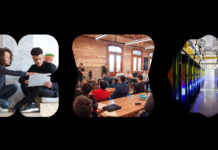By Miguel Amigot II
The initial process for learning innovators aiming to launch a large-scale online learning initiative may seem daunting, as there are many paths to getting started. This post offers information to help clarify best practices for learning initiatives supporting a significant number of students (above 10k) that expect to provide added value with innovative software and exceptional online learning solutions.
The classic dilemma is “build vs. buy” when launching an online learning ecosystem – should you build a proprietary platform from scratch or buy/license an existing platform?
- Building a proprietary platform allows your team to design the platform end-to-end, and control all integrations and intimate knowledge of your process.
- There is also the added benefit of no vendor lock-in, which gives you the ability to modify the platform in the future.
Building a platform will have a longer production timeline, in comparison to buying or licensing an existing one, and would also require the assembly of a dedicated team as an engineering organization: product, designers, frontend, backend, and devops. Depending on your organization, this could prove costly when factoring in salaries and staff opportunity costs.
Another consideration is that developing proprietary platforms is difficult. It must be extensible in order to incorporate future features (minimal technical debt). It must also be well-documented for the purpose of incorporating and training new staff on your proprietary solution. The level of difficulty will depend on the culture of your organization, the mindset of your engineers and any deadlines and short-term incentives to ship code.
Buying or licensing an existing platform comes with its own host of considerations. They offer immediate deployments and are reliable, given that you will most likely not be their only client. However, unlike the flexibility offered in building a platform, buying or licensing will include vendor lock-in — you will be unable to incorporate new features to the platform, unless the vendor decides that it’s worth it to include additional features unless you pay top-dollar to get them. In terms of cost, there will be expensive licensing fees, especially for a non-negligible number of students. Realistically, your organization could end up paying $100k – $220k per year to host 10k students.
Case Study: Global Knowledge
Global Knowledge, the largest private IT training company in the world, offers an interesting case study for this build vs. buy dilemma. About four years ago, Global Knowledge realized they needed a new learning platform that would support classroom, virtual and on-demand training. Their primary approach was to build the platform themselves. However, a year in, they realized their path of innovation was moving too slowly. Too much time was being spent shipping their needed features that were already available across a plethora of platforms, and they came to the realization that they would end up developing rudimentary features like multiple choice problems, rather than developing value-added features like custom labs or analytics.
Global Knowledge found that building their own proprietary platform offered too few features to start with, and an innovation timeline that was too long, so they chose not to build from the ground up an LMS for delivering on-demand training. They realized it would only make sense to build non-LMS capabilities, and developed a student portal, MyGK, that allows learners to access their courses, irrespective of their modality.
Global Knowledge’s second approach was to acquire an LMS startup to radically increase the features provided “out of the box.” This approach came equipped with staff to accelerate innovation. However, it was still too slow in comparison to its competitors and the at-large market of learning platforms. Although there were more features to begin with, the innovation was at a slightly higher slope but still unsatisfactory. Global Knowledge decided to make an acquisition in this space to accelerate the delivery of their learning platform, especially around digital asset management and jump-starting their team.
Finally, Global Knowledge’s third approach started in the winter of 2017-2018 under the new management of their Director of Engineer, Paul Tocatlian. The ask was simple: deliver a better solution that allows Global Knowledge to come out with a superior learning experience, cost-effectively, that allows faster innovation and can integrate with their existing backend systems.
For the reasons mentioned above, building their platform was not feasible. Neither was licensing a solution, as it would be inflexible and cost-prohibitive to license a learning platform with hundreds of thousands of users, costing Global Knowledge tens of millions per year. They had plans to innovate, and needed a cost-effective and flexible solution.
Given these considerations, Paul Tocatlian recommended using open source technology, and specifically Open edX. It comes equipped with most features, has the highest rate of innovation, extensibility, and integration. Open edX is also proven, built by MIT and Harvard for edx.org’s 16M+ learners. In the nonprofit and government fields, the Open edX technology is used by the US Air Force and millions of learners across XueTangX (China), FUN (France), Campus IL (Israel), and Edraak (Jordan and the Middle East).
As a practical example of Open edX’s extensibility, consider a recommendation engine (to put this into perspective, Amazon makes 30 percent of its sales from recommendations), which the platform does not currently support. They are focusing on this task, with zero vendor lock-in, by utilizing their own engineers and leveraging IBL’s consultancy services as their development partner.
More About Open edX
- For more information about Open edX’s reach, case studies, possibilities, comparisons, and models, please see ibleducation.com/open-edx
- The case of Global Knowledge: Video talk during the 2018 Open edX Conference in Montreal, Canada
Miguel Amigot II is the CTO at IBL Education (Open edX)

 En Español
En Español





















